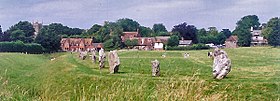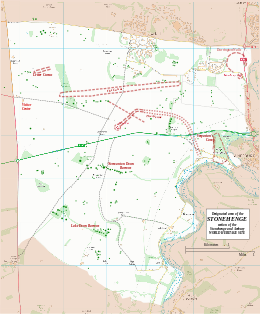Stonehenge World Heritage Site
Stonehenge and associated monuments

The Stonehenge area of the WHS is in south Wiltshire. It covers an area of 26 square km and is centred on the prehistoric monument of Stonehenge. Ownership is shared between English Heritage, the National Trust, the Ministry of Defence, the RSPB, Wiltshire Council, and private individuals and farmers.
Monuments in the Stonehenge WHS
- Stonehenge
- Stonehenge Avenue
- Stonehenge Cursus
- The Lesser Cursus
- Cursus Barrows
- Durrington Walls
- Woodhenge
- Cuckoo Stone
- Coneybury Henge (has been ploughed flat)
- King Barrow Ridge
- Winterbourne Stoke Barrows
- Normanton Down Barrows, including Bush Barrow
- Vespasian's Camp
- Robin Hood's Ball (an associated monument just north of the WHS boundary)
- West Amesbury Henge, also known as Bluestonehenge
Avebury and associated monuments

The Avebury area of the WHS covers an area of 22.5 km and is centred on the prehistoric Avebury Henge, about 17 miles (27 km) north of Stonehenge.
Monuments in the Avebury WHS
- Avebury Henge
- West Kennet Avenue
- Beckhampton Avenue
- West Kennet Long Barrow
- The Sanctuary
- Silbury Hill
- Windmill Hill
Museum and archive collections
The main museums are the Alexander Keiler Museum at Avebury, Salisbury Museum, and Wiltshire Museum in Devizes.
Other museums with material from Stonehenge and Avebury include the British Museum, National Museum of Wales, Cambridge University Museum of Archaeology and Anthropology and the Ashmolean Museum. Other archives include the Historic England Archive in Swindon, the Wiltshire and Swindon History Centre in Chippenham, and the Bodleian Library at Oxford.
See also
- Stonehenge Landscape – the land owned by the National Trust
- History of Wiltshire
References
- ^ Stonehenge Management Plan, 2009, English Heritage, p.22
- ^ King Barrow Ridge Research report Archived 2015-12-22 at the Wayback Machine, English Heritage, 2011


